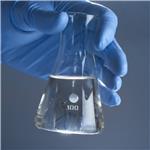Application research of 1-bromo-2-butyne
Introduction
1-Bromo-2-butyne (Figure 1) is an organic compound with the molecular formula C4H5Br. It is a pharmaceutical intermediate and can be used to synthesize linagliptin. This paper mainly lists application research of 1-bromo-2-butyne in organic synthesis.

Internal energy selected C4H5Br+ ions synthesis
Internal energy selected C4H5Br+ ions were prepared by vacuum ultraviolet photoionization from the bromobutyne constitutional isomers 4-bromo-1-butyne, 1-bromo-2-butyne, and 3-bromo-1-butyne. The lowest energy dissociative photoionization channel is Br-loss. 1-Bromo-2-butyne and 3-bromo-1-butyne cations are not metastable, and based on the threshold photoionization breakdown diagrams and neutral internal energy distributions, 0 K appearance energies of E0 = 10.375 ± 0.010 and 10.284 ± 0.010 eV are obtained, respectively. A kinetic shift has been observed in the Br loss of the 4-bromo-1-butyne cation, and the experimental dissociation rates were also modeled to obtain E0=10.616±0.030 eV. The energetics of the samples and nine C4H5 and C4H5+ structures are explored using G4 theory, which suggests that only the staggered 4-bromo-1-butyne rotamer cation loses Br to form a high-energy cyclic C4H5+ isomer, while the relative appearance energies indicate that 1-bromo-2-butyne and 3-bromo-1-butyne form the linear CH2CCCH3+ ion. The subtraction scheme for hot electron suppression in threshold photoelectron–photoion coincidence (TPEPICO) is discussed, and is used to introduce velocity map imaging (VMI-)PEPICO and data analysis. The derived onsets and the dissociation rate curve show that modeling VMI-PEPICO data taken close above or below the disappearance energy of the parent ion to obtain imaging breakdown diagrams is a feasible approach also in the presence of a kinetic shift. Imaging breakdown diagrams are advantageous when signal levels are low or short acquisition times necessary, such as in the case of reactive intermediates or in time resolved experiments, and can also be used as a fast molecular thermometer.[1]
On pentaorganylstiborane
The reaction of propargyl bromide (4a) with tributylstibine gave allenyltributylstibonium bromide (5), and its corresponding pentaorganylstiborane reacted with aldehyde to give homopropargylic alcohol (10a) exclusively in good yield. However, the reaction of 1-bromo-2-butyne (4b) with tributylstibine gave acetylenic stibonium bromide (6b), and its corresponding stiborane reacted with aldehyde to give allenic alcohol (9b) as major product. The reaction of 3-bromo-1-trimethylsilyl-1-propyne (4d) with tributylstibine also gave acetylenic stibonium bromide (6d), but the major product of the reaction of its corresponding stiborane with aldehyde was acetylenic alcohol (10d), and the regioselectivity was very high in the presence of LiBr. Further, it was found that the allenic stibonium bromide (12) was obtained by the reaction of 3-bromo-1-butyne (11) with tributylstibine. The corresponding stiborane (13) reacted with aldehyde to give acetylenic alcohol (14) exclusively in good yield, and the diastereoselectivity was moderately in favour of the threo isomer in the presence of MgBr2. All of the reactions had good chemoselectivity for aldehyde.[2]
A total synthesis of dl-cerulenin
A general route to endocyclic α,β-epoxy-γ-butyrolactones is described. The α,β-epoxylactones are potential protein cross-linking agents based upon the spectrum of reactivity displayed with amines and thiolate anion. The epoxylactone 8 is prepared from 1-bromo-2-butyne and serves as the key intermediate in a total synthesis of cerulenin (1), an important substance for the study of the enzyme systems involved in fatty acid biosynthesis.[3]
Reaction of zirconacyclopentadienes with electrophiles
Zirconacyclopentadienes reacted with electrophiles after treatment with alkyllithium. For example, the reaction with benzaldehyde after treatment with methyllithium to give a nucleophilic addition product of a dienyl moiety to aldehyde, dienylcarbinol, in a moderate yield. Similar reaction of a zirconacyclopentadiene using butyllithium with methyl methacrylate afforded a Michael addition product in a good yield. Treatment of zirconacyclopentadienes with n-BuLi followed by 1-bromo-2-butyne gave a mono-propargylated diene derivative in 95% yield after hydrolysis. When propargyl chloride was treated with n-BuLi first and then added to zirconacyclopentadienes, penta-substituted benzene derivatives were formed in high yields.[4]
References
1. Bodi A , Hemberger P .Imaging breakdown diagrams for bromobutyne isomers with photoelectron-photoion coincidence[J].Physical Chemistry Chemical Physics, 2013, 16.DOI:10.1039/c3cp53212g.
2. Zhang,Li-Jun,and,et al.On pentaorganylstiborane: III. Regio- and diastereoselective additions of acetylenic and allenic organoantimony compounds to aldehydes[J].Journal of Organometallic Chemistry, 1994, 471(1-2):77-85.DOI:10.1016/0022-328X(94)88110-3.
3. Robert,K,Boeckman,et al.A total synthesis of dl-cerulenin[J].Journal of the American Chemical Society, 1979, 101(4):987–994.DOI:10.1021/ja00498a032.
4. Seki T , Noguchi Y , Zheng D ,et al.Reaction of zirconacyclopentadienes with electrophiles such as benzaldehyde, methyl methacrylate and 1-bromo-2-butyne after treatment with RLi[J].Cheminform, 2004, 45(49):9041-9043.DOI:10.1016/j.tetlet.2004.10.030.
You may like
See also
Lastest Price from 1-BROMO-2-BUTYNE manufacturers

US $5.00/kg2025-04-21
- CAS:
- 3355-28-0
- Min. Order:
- 1kg
- Purity:
- 0.99
- Supply Ability:
- 10000

US $1.00/KG2025-04-21
- CAS:
- 3355-28-0
- Min. Order:
- 1KG
- Purity:
- 99%
- Supply Ability:
- 10 mt


